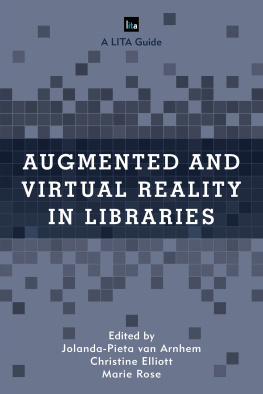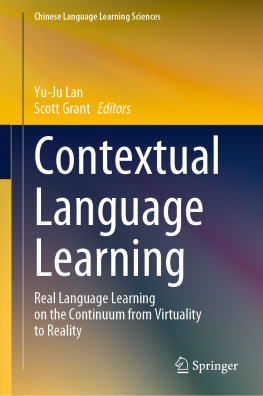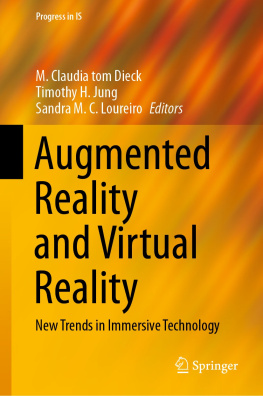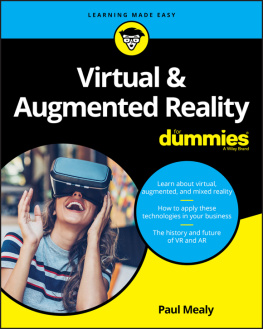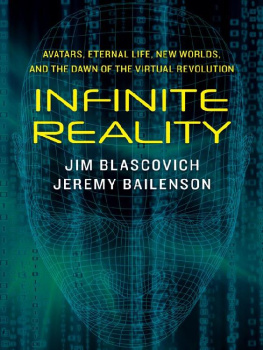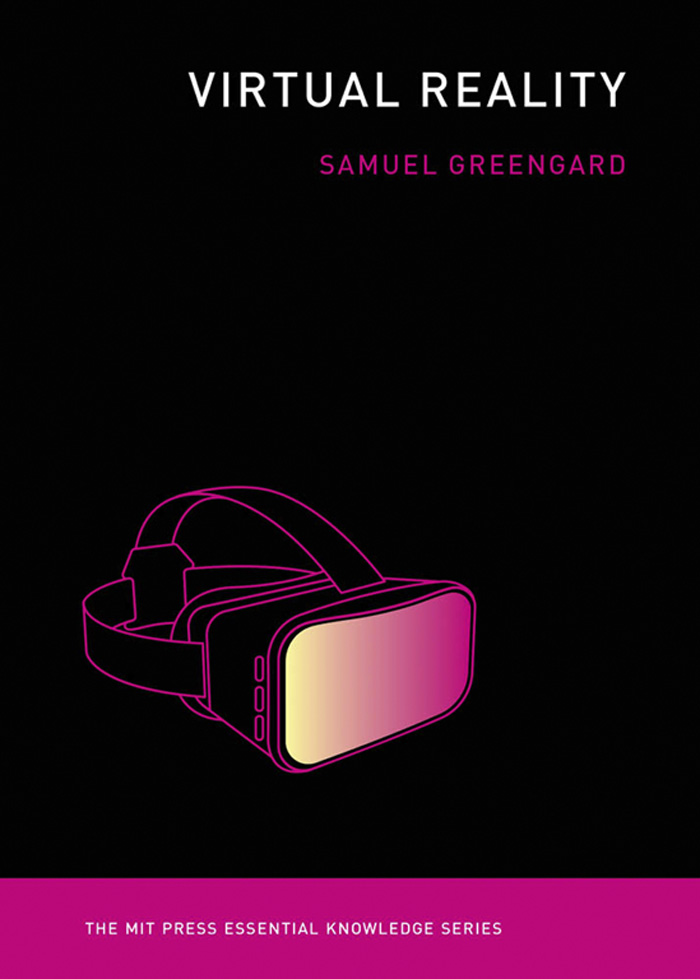
Virtual Reality
The MIT Press Essential Knowledge Series
A complete list of the titles in this series appears at the back of this book.
Virtual Reality
Samuel Greengard
The MIT Press | Cambridge, Massachusetts | London, England
2019 The Massachusetts Institute of Technology
All rights reserved. No part of this book may be reproduced in any form by any electronic or mechanical means (including photocopying, recording, or information storage and retrieval) without permission in writing from the publisher.
This book was set in Chaparral Pro by Toppan Best-set Premedia Limited. Printed and bound in the United States of America.
Library of Congress Cataloging-in-Publication Data
Names: Greengard, Samuel, author.
Title: Virtual reality / Samuel Greengard.
Description: Cambridge, MA : The MIT Press, 2019. | Series: The MIT Press
essential knowledge series | Includes bibliographical references and index.
Identifiers: LCCN 2018058335 | ISBN 9780262537520 (pbk. : alk. paper)
Subjects: LCSH: Virtual realityPopular works.
Classification: LCC QA76.9.C65 G745 2019 | DDC 006.8dc23 LC record
available at https://lccn.loc.gov/2018058335
10 9 8 7 6 5 4 3 2 1
Contents
Series Foreword
The MIT Press Essential Knowledge series offers accessible, concise, beautifully produced pocket-size books on topics of current interest. Written by leading thinkers, the books in this series deliver expert overviews of subjects that range from the cultural and the historical to the scientific and the technical.
In todays era of instant information gratification, we have ready access to opinions, rationalizations, and superficial descriptions. Much harder to come by is the foundational knowledge that informs a principled understanding of the world. Essential Knowledge books fill that need. Synthesizing specialized subject matter for nonspecialists and engaging critical topics through fundamentals, each of these compact volumes offers readers a point of access to complex ideas.
Bruce Tidor
Professor of Biological Engineering and Computer Science
Massachusetts Institute of Technology
Acknowledgments
The reality of writing a book is formidable. Virtual Reality was no exception. Quite a few people contributed to this project in one form or another.
First, Id like to thank MIT Press executive editor Marie Lufkin Lee, who approached me about writing another book for the Essential Knowledge series. We kicked around several ideas before deciding that extended reality warranted attention. I never regretted the decision, even when I was up to my eyeballs in research about complex technical concepts and sinking under the weight of detailed interviews with experts.
Id also like to thank several people who aided in developing content for this book. Accenture managing director Peter Soh and media relations specialist Hannah Unkefer extended an invitation to an Accenture showcase in February 2018. It highlighted leading-edge virtual-, augmented-, and mixed-reality systems and apps. They also provided access to several Accenture subject matter experts at the firm, including Marc Carrel-Billiard, Emmanuel Viale, Mary Hamilton, and Jason Welsh. These subject matter experts provided key ideas and concepts that helped frame the direction of the book.
Im also deeply grateful to Albert Skip Rizzo at the University of Southern California, who offered valuable insights into psychology, physiology, and the effects virtual reality has on humans, and Jeremy Bailenson at Stanford University, a thought leader in the field of virtual reality who provided key guidance about the topic. Thanks also to Jake Rubin, founder and CEO of HaptX, a company on the leading edge of VR systems development.
Of course, a book cant take shape without editors. Id like to tip my cap to Stephanie Cohen at MIT Press, who shepherded the project through to completion. She was extremely easy to work with and always available to answer questions or deal with issues. Id also like to acknowledge the diligence of Michael Sims at MIT Press, who caught numerous minor errors and typos while proofreading the manuscript. And thanks, too, to the four anonymous reviewers who provided valuable feedback about concepts and spotted a few omissions and errors along the way. Their comments and suggestions ultimately led to a much better book.
Id also like to thank my partner, Patricia Hampel Valles, for enduring ongoing discussions about virtual and augmented realityand for providing thoughts about key ideas and concepts that appear in the book. Finally, a shout out to my sons, Evan and Alec, who are emerging as smart young men. Both are now attending university and learning that knowledge is far more than the sum of YouTube videos and Wikipedia entries.
Introduction
Standing at the edge of an abyss that drops thousands of feet probably wouldnt rank as a bucket-list item for most people. Its more like a terrifying moment to avoid at any and all costs. But this doesnt change the fact that I must walk across a narrow ramp and board a spaceshipwith no time to spare. At this moment, my mental state could be described as somewhere between absolute bliss and sheer terror. My heart is racing while a queasy sensation has invaded the pit of my stomach. My brain, my eyes, and my senses tell me that with one wrong step I will plummet into oblivion. So, I take tiny and careful stepsone ... at ... a ... precious ... timeuntil I have managed to traverse the narrow ramp. As I enter the space vehicle I hear myself emit a sigh of relief.
Of course, Im not standing in a real spaceship. And I didnt cross an actual boarding ramp. Truth be told, Im not even remotely close to outer space. Im wandering through an immersive virtual-reality environment called The VOID, which is located in Las Vegas. Here, a visitor fastens a vest and gloves, dons a virtual-reality head-mounted display, and ventures into a holodeckan environment that blends physical and virtual reality. Ive just entered a Star Wars battle called Secrets of the Empire. Once inside this space, the bare walls, floors, and ceilings of the holodeck morph into the spaceship. Im actually a participant in a Star Wars film. Its a 3D world where I can feel heat and vibrations, smell damp air and smoke, hear the sounds of battle, and, using my proton blaster, a laser gun, take out enemy storm troopers.
The experience, which lasts about 20 minutes, is at times exhilarating and at other times completely terrifying. Throughout the adventure, however, its entirely convincing. The VOID is unlike any form of entertainment Ive ever experienced. It is to virtual reality what recordings are to music or smartphones are to communication. The space seamlessly weaves together reality and fantasy to advance the boundaries of entertainment to a new frontier. Forget the flat screens and 2D experience that TVs, computers, and movies deliver. This immersive world seems completely and utterly real. The VOID website describes the environment as hyperrealism.
The VOID represents the leading edge of a massive wave of virtual reality, augmented reality, and mixed reality. In family rooms, offices, and research labs around the world, people are using special goggles or head-mounted displaysalong with haptic gloves and other apparatusto venture inside a computer-generated world that convincingly mimics our physical world. In addition, many are turning to augmented-reality eyeglasses and smartphone apps to view data, graphics, and images in new and intriguing ways. These capabilities are available on demand at the push of a button or via a voice command.
Next page

